Multnomah County has just launched a virtual open house for the Sellwood Bridge project and they’re looking for your input on key design and funding decisions.
Among the many aspects of the project featured in the open house is the design of the multi-use path and bicycle traffic lane. The new bridge, which could break ground this winter, will have a 12-foot multi-use path to be shared by people on bike and on foot, as well as a 6 and 1/2 foot lane solely for bicycling.
Citizen’s Advisory Committee member Richard Marantz (who gave me a tour of the bridge a few years ago) explains the bicycling design issues in a video that’s part of the online open house.
Richard Marantz – Surface Treatments from JLA Involve on Vimeo.
“Given that there is going to be such diverse use of the bridge,” he says, “we’ve been focusing on a means of separating the different users safely on the bridge so that everyone has a good experience.”
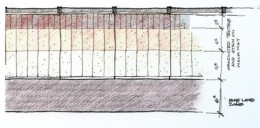
pavement concepts.
Marantz says they are looking for public input on how best to communicate that separation through the surface treatments. Beyond pavement markings similar to what’s used on the Hawthorne Bridge, they are considering different colored concrete and scoring patterns. “We’re asking for input on whether people want these special treatments and what they might be.”
In addition to feedback on the bicycle traffic lane and multi-use path, the County also wants your input on how to cut costs to close a $20 million funding shortfall.
The virtual open house is open until August 21st and feedback received by that date will be presented to the Citizen’s Advisory Committee at their meeting on August 22nd. A final decision on the design for the new bridge will be made by the Multnomah County Board of Commissioners this fall and construction of the bridge structure will start next July.
Weigh in and learn more at SellwoodBridge.org.


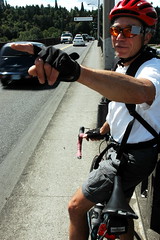
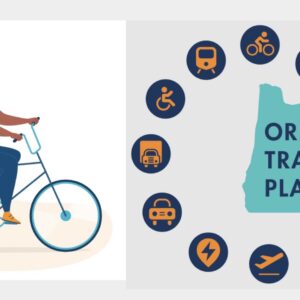
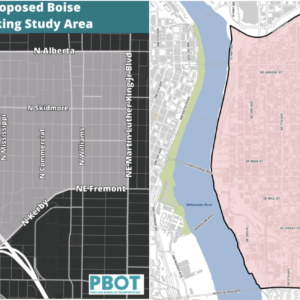
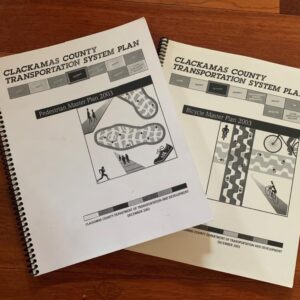

Thanks for reading.
BikePortland has served this community with independent community journalism since 2005. We rely on subscriptions from readers like you to survive. Your financial support is vital in keeping this valuable resource alive and well.
Please subscribe today to strengthen and expand our work.
Thank you, Richard, for representing the Bicycle Transportation Alliance on this issue.
Yes, surface treatments would be welcome! Every little detail makes it safer.
They want to delineate different speed zones within the MUP and bike lanes.
I think the most reliable is to use well recognized MUTCD established road markings that most everyone will recognize without needed explanation.
In Section 3 – Markings Figure 3B-26. “Yield Ahead Triangle Symbols” we see yield markings of different lengths based on the posted speed. From here we can mark the bike lane icons in decreasing length as their distance from the pedestrian area decreases; also adding a pedestrian and wheelchair icon to the pedestrian area implys an area of more caution and less speed.
You could separately include a “pixel dithering” pattern of ADA Truncated Domes whereby the domes are spaced infrequently in high speed cycling areas and in ever increasing density up to the density specified by the FHWA for sidewalk design guidelines. From there the section of sidewalk furthest from high speed traffic would have no domes and be optimized for ADA requirements.
The advantage of this technique is three fold: speed control and separation is exercised automatically by the rider, auditory feedback from tire noise increases safety of the all users including the blind and visually impaired users have more feedback on the path of safest usage.
except that isn’t “what’s used on the Hawthorne Bridge”, it’s what’s used on the eastside viaduct approaching the Hawthorne Bridge. The bridge itself just has the symbols in the circles and the directional arrows, but no demarcation line.
I think that having in a fast bike lane and a slower bike lane is brilliant – It will eliminate the quandary about which side to pass if one is in a rush (or the rider in front is even more of a dawdler than I am when admiring the view).
It’s going to be sooo much better that I expect to love it no matter how it is configured as will thousands of others, so delineating space does seem appropriate and I’m in favor of giving pedestrians (and walking cyclists) plenty of their own space near the railings.
Now I’ll go weigh in…
The markings on the Hawthorne are mostly observed by its users, but I still see a lot of exceptions (slow riders or the occasional pedestrian way over on the left), and sometimes it REALLY gums up the works at peak times, not to mention leading to dangerous passing-on-the-right situations. Surface treatments would definitely help.
So you cross over to the west side of the Sellwood, where do you go? Straight up through the boneyard if you got the legs. Left and battle traffic to Lake “O” if you got the nerve. Right towards downtown if you got a map to find the disjointed bike path. Hopefully the improved bridge will lead to more infrastructure on the east side for bikers.
Sorry I meant WEST side…
Why is passing on the right dangerous? If you’re in such a rush that you have to pass a slower rider who is properly riding on the bicyclist’s side of the shared “multi-use path” on the Hawthorne bridge, you should be able to judge when it is safe to do so.
The common practice of cyclists weaving in and out of groups of pedestrians (on the side of the path designated for walking) while speedsters zip by on their left seems far more dangerous (not to mention confusing).
Hopefully it will be possible to switch (bicycle) lanes on the new Sellwood bridge so that it will be safe to pass slower riders on their left (in the fast lane) when there’s a break in speedy bike traffic.
I’m ready, since I installed twin rearview mirrors on my recumbent.
Because most people aren’t expecting to be passed on the right. So when someone is passing left and right then the people being passed don’t know what the next passer is going to do, and then you get hordes of people motivating (wheels or feet) in a mob instead of nice, traffic flow (slower traffic to the right, faster to the left).
I also despise the people who weave in and out of groups of slower traffic (foot, car, or bike). It’s dangerous. If you want to pass, watch for your gap in the faster traffic, get into it and speed up to the speed of that lane until you get past the people you wanted to pass. Then get back over, or keep up with the flow of faster traffic. Simple.
except every one’s definition of “fast” is not the same. For me, the majority of people are not going “fast” on the hawthorne. I think just a wider path is the solution that’s best, as they you can have two lanes of bikes going the same way, and people can still walk two abreast.
The notion that there is an obvious, simple, intuitive, correct way for passing on the Hawthorne bridge is belied by the fact that *every* single time this comes up here on BikePortland there are strong and convincing arguments for more than one point of view. So please, next time you’re stuck behind someone doing it wrong, take a deep breath and put yourself in their pedals.
Why does this Sellwood Bridge CAC member
Richard Marantz have a picture of him with his leg slung over the top bar of his bike? It looks like he just stopped to be photographed. You are supposed to be walking your bike on the sidewalk. There are signs posted at each end of the bridge.
I can’t believe we are still talking about cutbacks.
Make the Cheap #@^$%& from Clackamas county pay their share or TOLL IT !!!